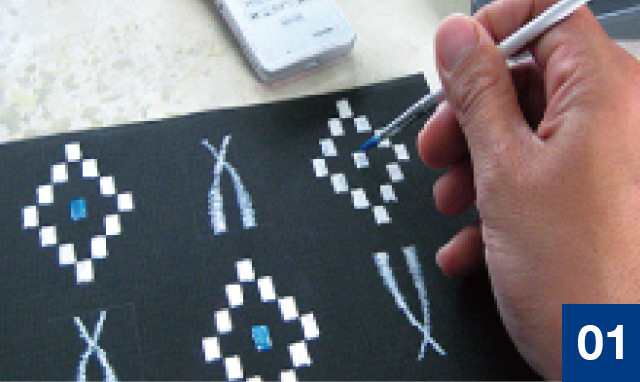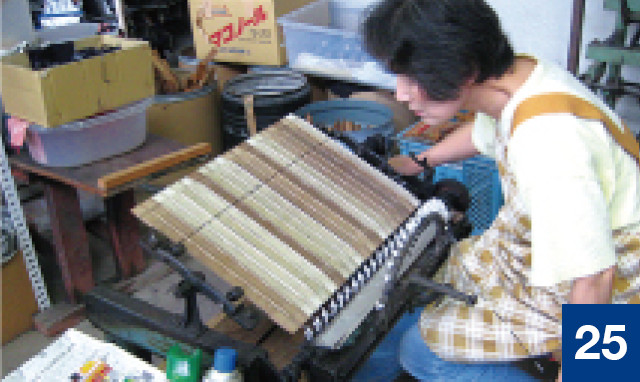

There are more then 30 processes, that takes 2 months to completion.
We hope the steps presented here, will make you share our passion for Kasuri fabrics.

The texile pattern design,This is the starting point of Kurume-Kasuri production.
Designed pattern is translated into unique quare dots, and plotted on graph-paper like sheets.Up to 1,100 threads will be used for just one pattern.
Threads are rolled into unique loom, to prepare for patterned colouring and threading.
Fabrics shrink whenwoven. The slightly change in dimension is taken into consideration and the base design is adjusted accordingle.
Threads are marked at location, to prepare for dyeing.
Number of vertical threads that is required to creat the pattern. Usually between 750-1120.
Required amount of threads are prepared at this stage.
Threads are placed in boiling water for 2-4 hours, to rid of any impurities that will compromise the finish.
Required before dying, to enhance the colour.
This strengthen the threads, and eases the following processes.

Threads of hemp is woven into the thread to act as sealant Sealed part will be white, while uncovered part will becom indigo.
Preparing the all natural, traditional tone of indigo, of kasuri fabrics.

Threads are beaten into the indigo dye. The air trapped in the beating will cause oxidation, making the colour long-lasting. This process is repeated 15-20 times.
Fabric is cleansed in clean water.

Sealing threads are untied from the fabric, revealing patterns.
Washed in water again, to bring up the colours.
To ensure the patterns do not come slack, starch is again applied to the fabric.

Vertical threads are laid out in a way to form the final pattern.
White threads without colour is merged with the dyed threads.
Vertical threads are prepared, rolled into a shape for the final weaving.
Threads are set in the shuttle.
Each vertical threads are set in the loom, at pre-designed length.
Threads are divied, to match the final design.
Divied threads are set into shuttle.

Hand-woven fabrics are rolled with a bamboo stick, machine operated looms are rolled into a timbre plate called a tomgue.

The loom is operated either by hand or other mechanical power. Both requires experience and technique.
Woven fabric is washed lightly for the final time in hot water, to prevent shrinkage and decolorisation. Starch is washed out, and the fabric retains its comforting texture.
Search throughly foe any imperfections. Once the quality is assured, fabric is measured and folded.
Kurume-Kasuri producers association will perform the final inspestion, before the fabric is ready to be presented to the customers.